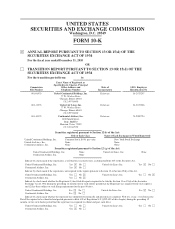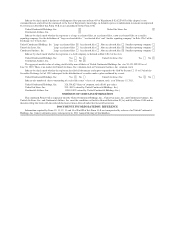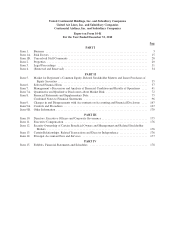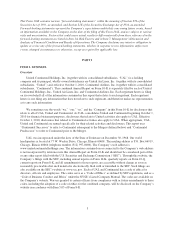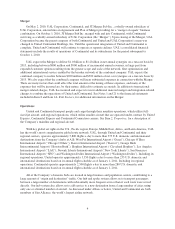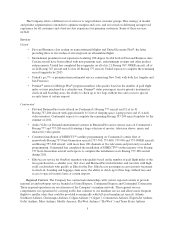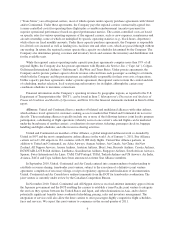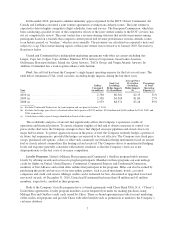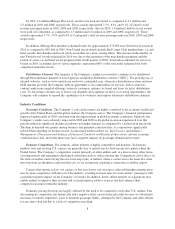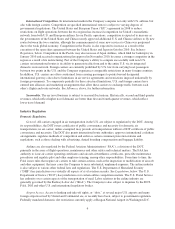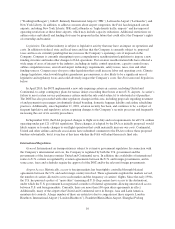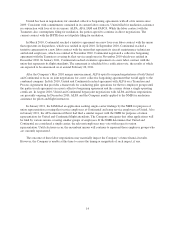United Airlines 2010 Annual Report Download - page 9
Download and view the complete annual report
Please find page 9 of the 2010 United Airlines annual report below. You can navigate through the pages in the report by either clicking on the pages listed below, or by using the keyword search tool below to find specific information within the annual report.
In December 2010, pursuant to antitrust immunity approval granted by the DOT, United, Continental, Air
Canada and Lufthansa executed a joint venture agreement covering trans-Atlantic routes. The joint venture is
expected to deliver highly competitive flight schedules, fares and service. The European Commission, which has
been conducting a parallel review of the competitive effects of the joint venture similar to the DOT’s review, has
not yet completed its review. The joint venture has a revenue-sharing structure that results in payments among
participants based on a formula that compares current period unit revenue performance on trans-Atlantic routes
to an historic period, or “baseline,” which is reset annually. The payments are calculated on a quarterly basis and
subject to a cap. The revenue sharing aspects of this joint venture were retroactive to January 2010. See Industry
Regulation below.
United and Continental have independent marketing agreements with other air carriers including Aer
Lingus, Cape Air, Colgan, Copa Airlines, Emirates, EVA Airways Corporation, Great Lakes Aviation,
Gulfstream, Hawaiian Airlines, Island Air, Qatar Airways, TACA Group, and Virgin Atlantic Airways. In
addition, Continental has a train-to-plane alliance with Amtrak.
Fuel. Aircraft fuel has been the Company’s single largest operating expense for the last several years. The
table below summarizes UAL’s fuel cost data, excluding hedge impacts, during the last three years.
Year
Gallons
Consumed
(in millions)
Fuel Cost
Excluding
Hedge Impacts
(b) (in millions)
Average Price
Per Gallon
Excluding
Hedge Impacts
(b)
Percentage
of Total
Operating
Expense (c)
2010 (a) ....................................... 2,798 $6,581 $2.35 31%
2009 (a) ....................................... 2,338 $4,308 $1.84 27%
2008 (a) ....................................... 2,553 $8,371 $3.28 39%
(a) Excludes Continental Predecessor fuel consumption and cost prior to October 1, 2010.
(b) Excludes fuel hedge gains (losses) classified within fuel expense of $(105) million, $104 million and $(608) million for 2010, 2009, and
2008, respectively.
(c) Calculation excludes special charges identified in Item 6 of this report.
The availability and price of aircraft fuel significantly affects the Company’s operations, results of
operations and financial position. To ensure adequate supplies of fuel and to obtain a measure of control over
prices in the short term, the Company arranges to have fuel shipped on major pipelines and stored close to its
major hub locations. To protect against increases in the prices of fuel, the Company routinely hedges a portion of
its future fuel requirements, provided the hedges are expected to be cost effective. The Company uses fixed price
swaps, purchased call options, collars or other such commonly used financial hedge instruments based on aircraft
fuel or closely related commodities like heating oil and crude oil. The Company strives to maintain fuel hedging
levels and exposure generally consistent with industry standards so that the Company’s fuel cost is not
disproportionate to the fuel costs of its major competitors.
Loyalty Programs. United’s Mileage Plus program and Continental’s OnePass program build customer
loyalty by offering awards and services to program participants. Members in these programs can earn mileage
credit for flights on United, United Express, Continental, Continental Express and Continental Connection,
members of Star Alliance and certain other airlines that participate in the programs. Miles can also be earned by
purchasing the goods and services of our non-airline partners, such as retail merchants, hotels, car rental
companies and credit card issuers. Mileage credits can be redeemed for free, discounted or upgraded travel and
non-travel awards. At December 31, 2010, United and Continental had more than 58 million and 41 million
members, respectively, enrolled in their programs.
Both of the Company’s loyalty programs have co-brand agreements with Chase Bank USA, N.A. (“Chase”).
Under these agreements, loyalty program members accrue frequent flyer miles for making purchases using
Mileage Plus and OnePass credit cards issued by Chase. These co-brand agreements provide for joint marketing
of the credit card programs and provide Chase with other benefits such as permission to market to the Company’s
customer database.
7

